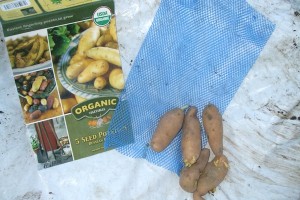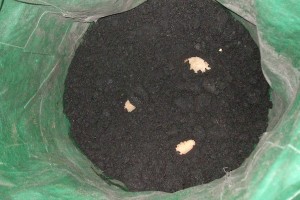
About 10 ounces of potatoes were harvested this year. (C) Jo Ellen Meyers Sharp
For the second year in a row, I’ve grown potatoes in two resin cloth planters that I purchased at a local garden center.
Potatoes are like sponges, soaking up whatever chemicals and other products that might be sprayed on the crop, so I opt to grow organic. This year, I planted Russian banana fingerlings, which are supposed to get to be the size of a fat finger.

(C) Jo Ellen Meyers Sharp
Of course, you can grow potatoes in the ground, but because I have a small yard, the planters work best for me. The planters don’t take up a lot of room and I can put them near the vegetable garden without giving up valuable tomato space. Still, the 10-ounce harvest in 2012 was about the same as 2011.
Potatoes are one of the earliest plants sown in spring, usually in mid-March. Seed potatoes are sold in bulk or in packages in garden centers or through online retailers. It’s best to buy fresh, disease free seed potatoes. Planting potatoes from the super market is not recommended.
Cut the seed potatoes so that each piece has one or two eyes, or growth buds. Plant four inches deep immediately in loose, organically rich, well-drained soil in full sun. As the plants grow, add more soil, called hilling, to cover the base of the vines. Apply an all-purpose granular fertilizer, such as Espoma Garden-Tone or similar natural product according to label directions. Water as needed.

(C) Jo Ellen Meyers Sharp
Continue hilling new growth with soil ever few weeks until late summer. For my planters, I buy inexpensive top soil for this task.
In late fall or early winter, harvest the potatoes from the soil with a garden fork or dump the planters. Brush off the soil and store the potatoes in a cool dry area. Or in my case, invite friends for a dinner that includes this year’s crop of potatoes roasted in the oven with carrots and chunks of onion.